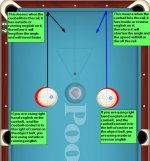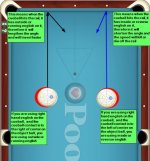Any of my answers would be based on one simple theory. That your contact point of the cueball hitting the object ball, is on one side or the other of center. Even if by a millimeter or two... It has to be on one side or the other. I don't know what you call it, if it is ever hit dead center.

Hopefully this image will describe it better.
 View attachment 185914
View attachment 185914
Ok, time out, if I may interject here. Lots of people use the term english when a hit on the CB is anything other than center hit. Lots of other people only use the term english when the CB is hit off the center vertical axis. I fall into the latter group, but I don't think either way is all that important regarding explaining what you are doing to the CB.
FAR MORE IMPORTANT is what I'm reading, an seeing in your diagram that confuses the relationship of inside or outside english with running or reverse english.
THESE TWO TERMS DO NOT INTERRELATE at all, other than by complete coincidence.
Now allow me to totally confuse you!
In your diagram the sidespin on the CBs are NEITHER inside or outside english. They are also coincidentally neither running or reverse english.
In this diagram running english is DRAW!!!!! Reverse english is FOLLOW!!!!!
Now to explain. Running or reverse english refers to what the natural rotation of the CB is based on THE DIRECTION OF ITS TRAVEL around the table.
If a CB is going to travel clockwise around the table, then natural english is right hand english period. If the CB is moving in the direction to travel counter clockwise around the table then running english is left hand english period.
Putting the opposite english on the CB in the above situation is reverse english.
RUNNING and REVERSE english terms are used ONLY with relation to the CB TRAVEL around the table.
INSIDE and OUTSIDE english are used ONLY in terms of the CBs contact with an OBJECT BALL. Inside english is the english on the CB closest to the contact point on the OB when hitting the CB. So, if you are cutting a shot to the left, the left side of the CB will hit the OB, so left english is Inside English in this case. Outside english is the opposite. Simple as that. Nothing to do with anything else.
Inside english may or may not be running english. Outside english may or may not be running english.
The use of inside or outside english when contacting an object ball will effect the natural path of the CB after the CB contacts an OB and goes on to contact a rail of course, but the use of these terms should only be used in connection with the contact of the CB to the OB.
Unlike running or reverse english which doesn't need contact with an object ball to be described, since its description is based on the direction of the CB around the table. Either clockwise or counter clockwise.
In your diagram you are shooting DEAD into the rail. SOOOO, what will be the normal direction of the CB once it contacts the rail? Normal direction, is not left or right. Normal direction is right back at you, straight back.
So technically if the normal direction is straight back at you, running english would be draw (if you wish to call draw or follow english) since thise spin compliments the CBs natural rotation as it travels off the rail.
Follow spin off the rail spins the CB counter to its natural rotation off the rail on a straight back, so technically that would be reverse.


